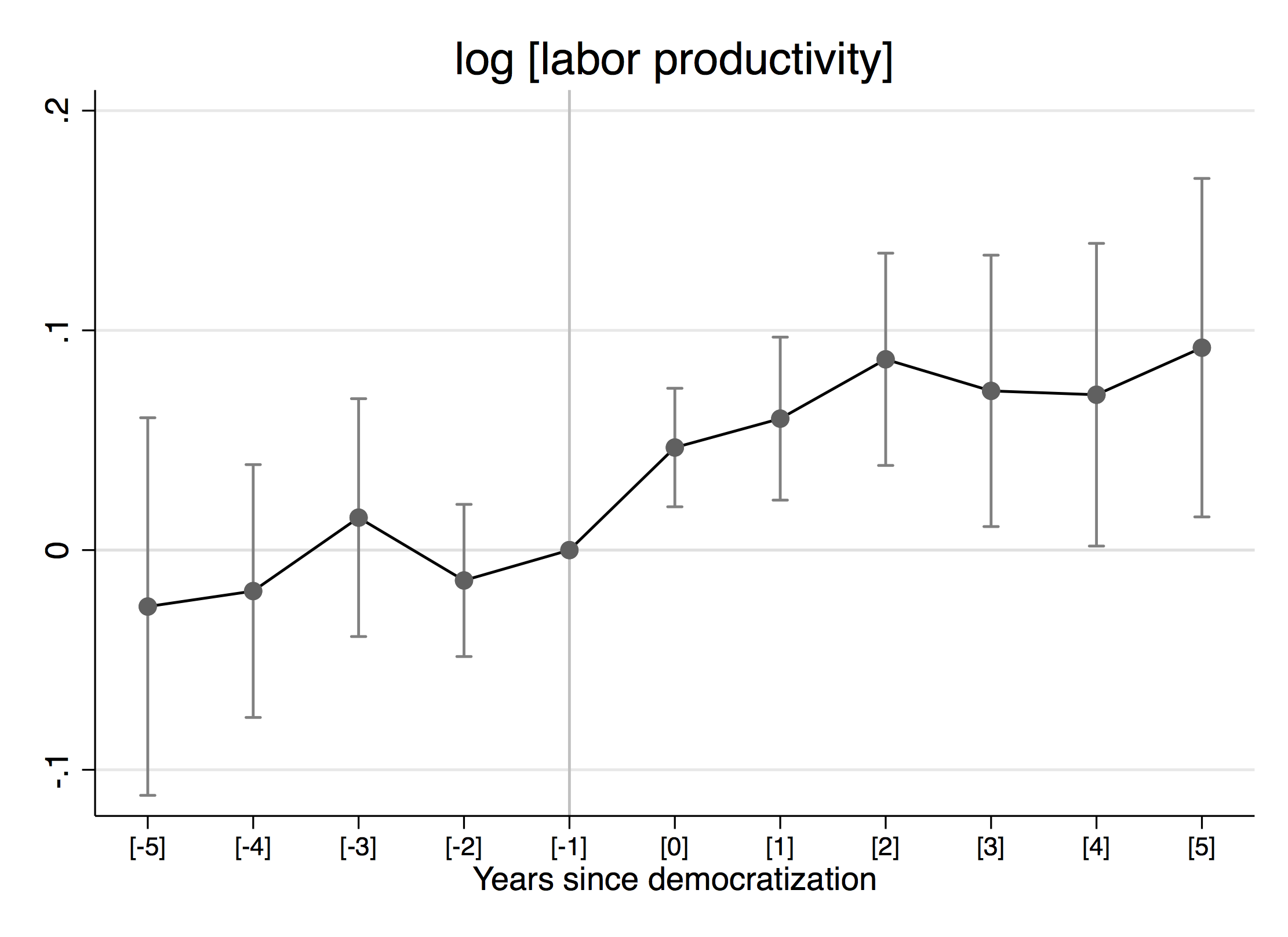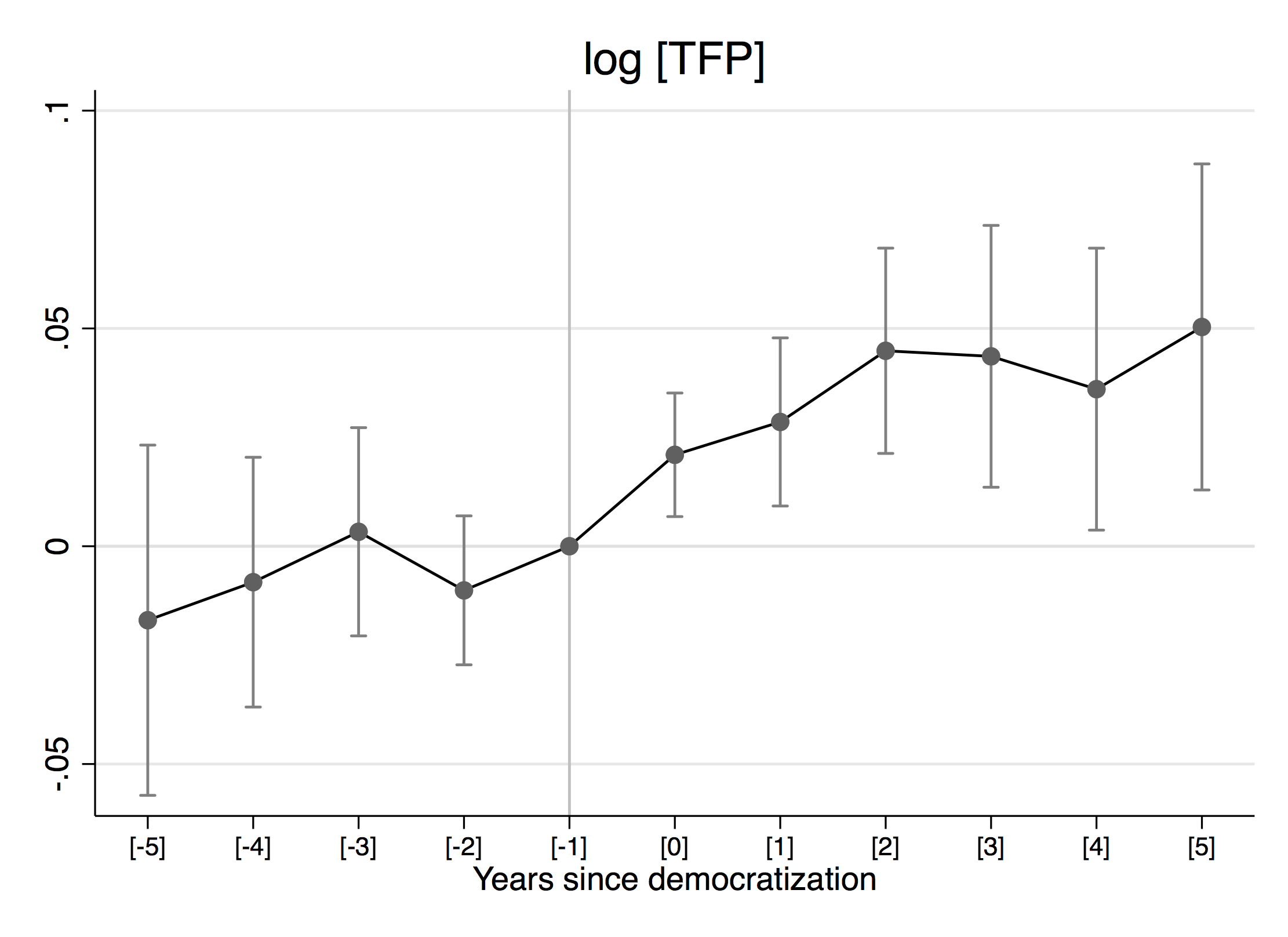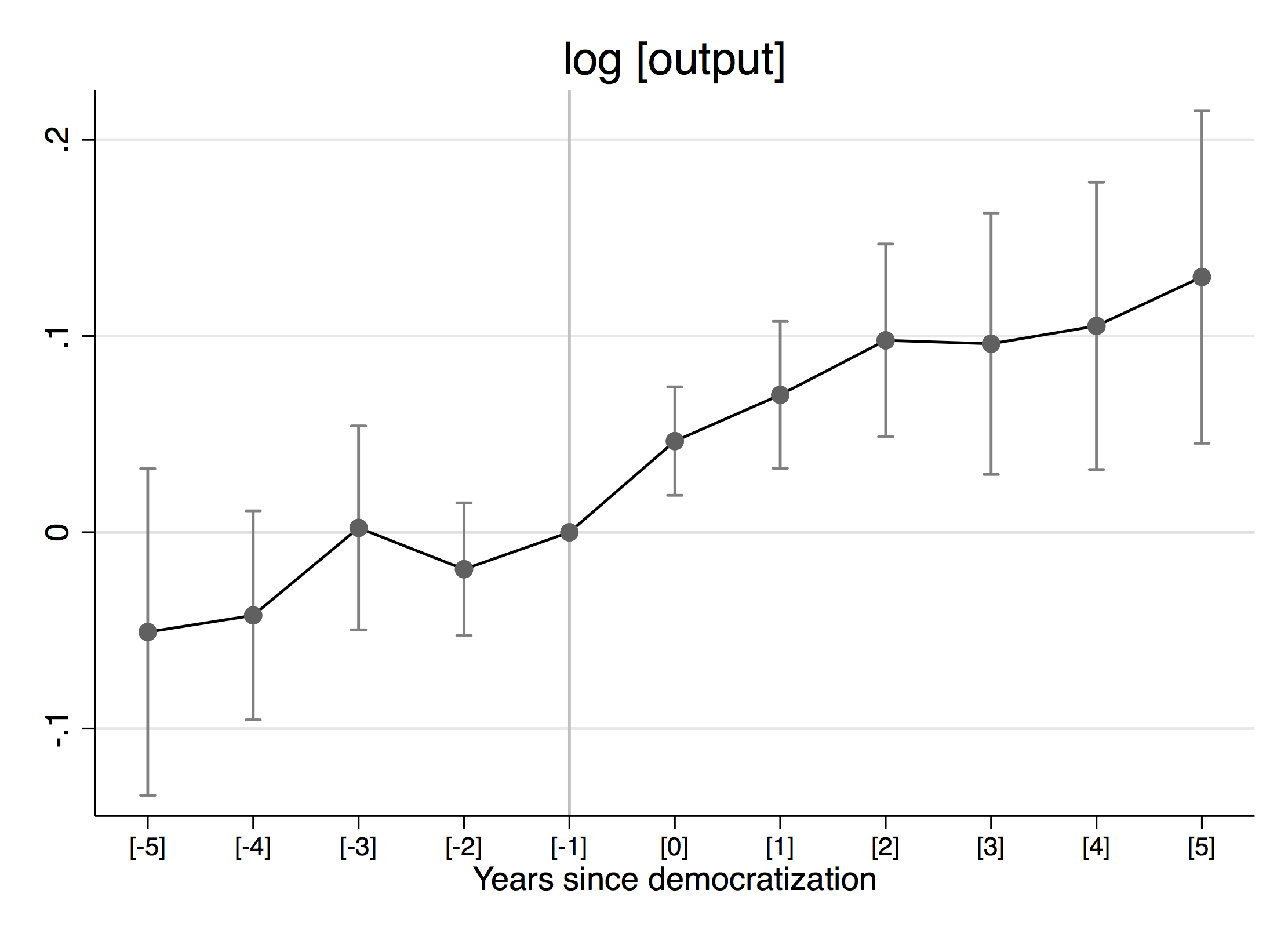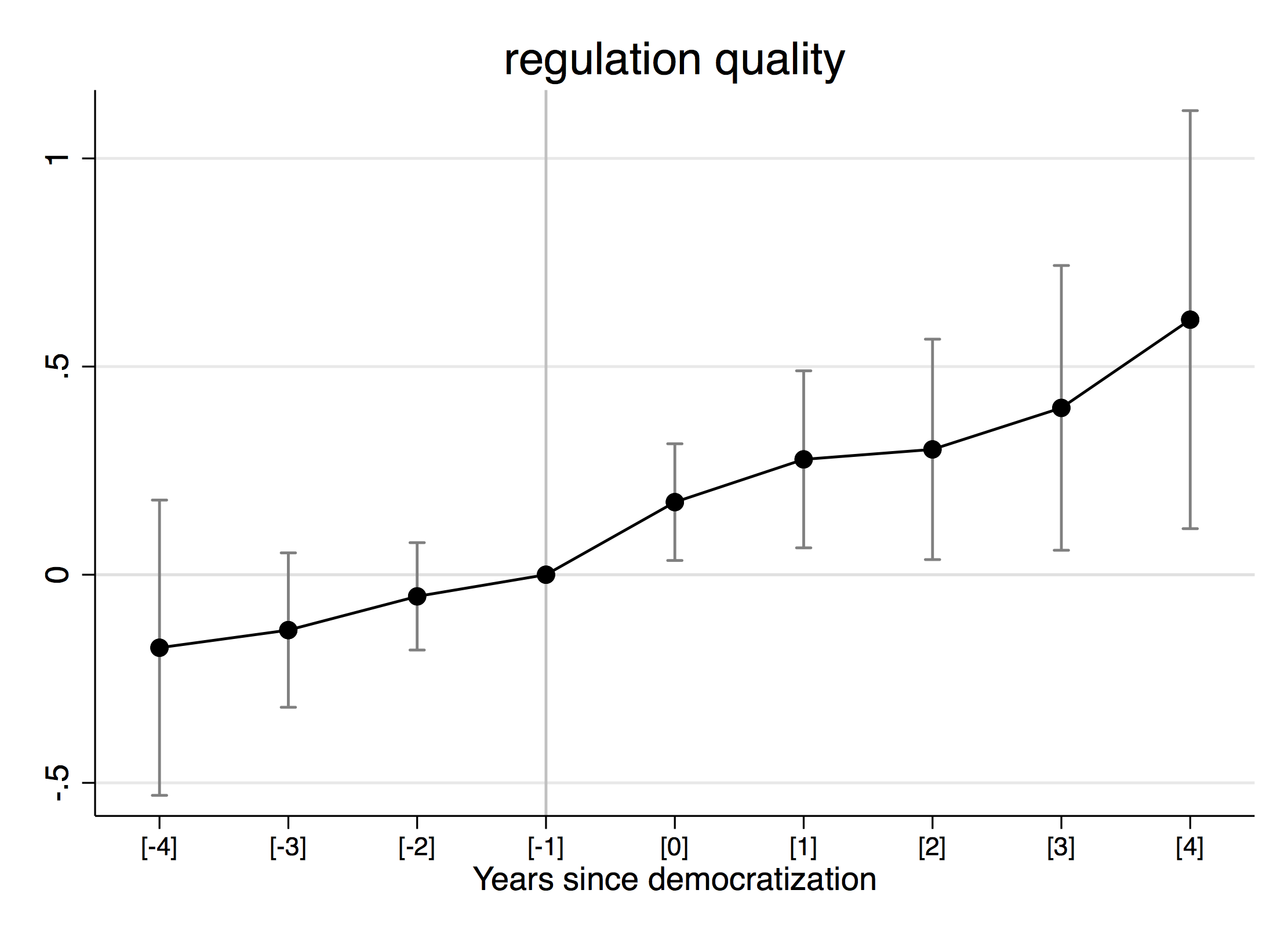
Democratically elected leaders are less likely to impose socially inefficient regulations or engage in rent-seeking and, hence, enhance firm productivity
The relationship between democracy and growth has attracted much research and debate over the past few decades. Some scholars have theoretically argued that certain types of autocracies may be good for economic growth. In contrast, others have posited that democratic institutions enhance growth. Earlier empirical work on the relationship between democracy and growth found a negative effect of democracy on growth (Barro 1996, Tavares and Wacziarg 2001) or, at best, no effect (Burkhart and Lewis-Beck 1994). More recent studies, which use multiple strategies to address the issues in establishing a causal relationship, point towards a positive relationship between democracy and growth (Rodrik and Wacziarg 2005, Persson and Tabellini 2008, Papaioannou and Siourounis 2008, Acemoglu et al. 2019). Despite this evidence on the impact of democracy on economic growth, we still do not know much about the micro-drivers of the relationship.
Democratic institutions may lead to greater economic growth
In Abeberese, Barnwal, Chaurey, and Mukherjee (2021), we study how democratisation affects firm productivity -- a critical micro-driver of economic growth. We do so in the context of Indonesia, which had been under the dictatorial rule of Soeharto for three decades, until the unexpected collapse of his regime in 1998. Using the exogeneous timing of when each district in the country transitioned to a democracy, we estimate the causal effect of democratisation on firm productivity. In particular, we use the fact that the Soeharto-appointed district mayors were allowed to complete their five-year terms instead of being immediately replaced by democratically elected mayors. This provides us with variation across districts and over time in when the political regime changed. We combine data on the timing of democratisation with an annual census of manufacturing firms over two decades to analyse the impact of democratisation on firms using an event study design.
Firms have higher productivity and output under democratically elected mayors
Figure 1 shows firm-level outcomes in the years leading up to, as well as the years following, the year in which the district switched to having a democratically elected mayor. Panels (a) and (b) depict the dynamics of labour productivity, which is defined as output per worker, and total factor productivity (TFP), respectively. In line with the exogenous timing of democratisation, there were no differential trends in labour productivity in the years leading up to the district switching to fully democratising. After a district fully democratises, firm productivity increases. Panel (c) conducts the same exercise for output. Once again, we see a clear pattern: firm output increases significantly after the switch to a democratically elected mayor.
Figure 1
Panel (a)

Panel (b)

Panel (c)

Better regulations under democracy drives firm productivity
Next, we explore the extent to which differential local business regulations under Soeharto versus democratic mayors may have affected firm productivity. To do so, we use a unique dataset, collected by Komite Pemantauan Pelaksanaan Otonomi Daerah (KPPOD), on the quality of regulations passed in Indonesia. This dataset includes regulations on licensing, transportation of goods and services, employing labour, and taxes and levies. KPPOD had assessed the quality of each regulation with respect to incentives for economic development by analysing whether the regulation satisfied 14 different criteria (see Figure 2). Similar to our results on firm productivity and output, we find that the quality of regulations also improves with a district switching to a democratically elected mayor.
Figure 2

Since democratisation improved both firm outcomes and the quality of business regulations, a natural question to ask is whether the change in the quality of regulations is related to the improvement in firm outcomes. We find suggestive evidence for this. We document that the positive effects of democratisation (on labour productivity and output) are indeed correlated with an increase in the number of regulations satisfying all criteria. Moreover, we also find suggestive evidence that democratically elected mayors were introducing more regulations, specifically in categories correlated with improved firm outcomes. Consistent with these results, we find that firms’ perception of the business environment in the district also improved after democratisation.
Conclusion
Our findings suggest that democratic leaders are less likely to impose socially inefficient regulations or engage in rent-seeking and, hence, enhance firm productivity. Our work, together with the growing evidence on the positive effect of democratisation on outcomes such as health and education (Besley and Kudamatsu 2006, Kudamatsu 2012, Fujiwara 2015, Martinez-Bravo et al. 2017), infrastructure (Burgess et al. 2015) and deforestation (Morjaria 2018), points to the existence of a positive effect of democratisation on economic development and overall economic growth.
References
Abeberese, A B, P Barnwal, R Chaurey and P Mukherjee (2021), “Democracy and firm productivity: evidence from Indonesia”, The Review of Economics and Statistics, forthcoming.
Acemoglu, D, S Naidu, P Restrepo and J A Robinson (2019), “Democracy does cause growth”, Journal of Political Economy 127(1): 47–100.
Barro, R J (1996), “Democracy and growth”, Journal of Economic Growth 1(1): 1–27.
Besley, T and M Kudamatsu (2006), “Health and democracy”, American Economic Review 96(2): 313–318.
Burgess, R, R Jedwab, E Miguel, A Morjaria and G Padró i Miquel (2015), “The value of democracy: evidence from road building in Kenya”, American Economic Review 105(6): 1817–51.
Fujiwara, T (2015), “Voting technology, political responsiveness, and infant health: evidence from Brazil”, Econometrica 83(2): 423–464.
Kudamatsu, M (2012), “Has democratization reduced infant mortality in sub-Saharan Africa? Evidence from micro data”, Journal of the European Economic Association 10(6): 1294–1317.
Martinez-Bravo, M, P Mukherjee and A Stegmann (2017), “The non-democratic roots of elite capture: Evidence from Soeharto mayors in Indonesia”, Econometrica 85(6): 1991–2010.
Morjaria, A (2018), “Democracy and the environment: evidence from Kenya”, Working Paper.
Papaioannou, E and G Siourounis (2008), “Democratisation and growth”, The Economic Journal 118(532): 1520–1551.
Persson, T and G Tabellini (2008), “The growth effect of democracy: is it heterogeneous and how can it be estimated?”, in E Helpman (ed.), Institutions and Economic Performance, Harvard University Press.
Tavares, J and R Wacziarg (2001), “How democracy affects growth”, European Economic Review 45(8): 1341 – 1378.
Endnotes
1 The 14 criteria are: healthy competition; lack of negative economic impacts; lack of obstacles to public access and the public interest; no violations of governmental authority; free flow of goods, services and persons; no disconnect between aims and content; clarity of the objects of the regulation; clarity of the subjects of the regulation; clarity of rights and obligations of fee payers and the local government; clarity of time standards, costs, and procedures or rate structure and standards; conformity between the philosophy and the principles of taxation; compliance with relevant superseding laws; use of up-to-date legal references; completeness of the text of the regulation in terms of basic information on jurisdiction, tariff formulae, and period of validity.




